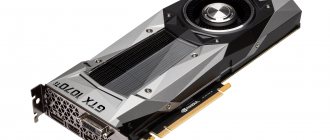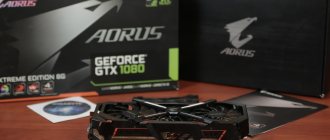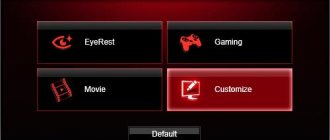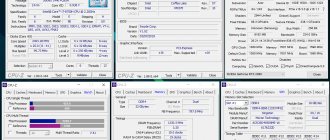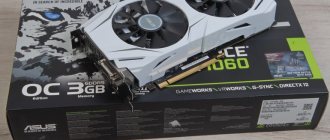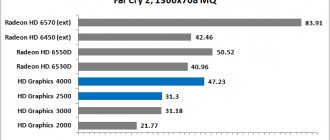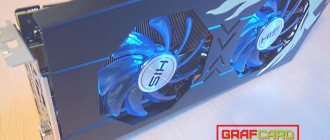At the moment when AMD rolled out the new Radeon RX Vega 56 and Radeon RX Vega 64 models to the market, a strategy for restoring parity was already being developed in the NVIDIA green camp. There was a big gap in NVIDIA's graphics product line between the GeForce GTX 1070 and GeForce GTX 1080, where competing solutions from AMD squeezed in. Therefore, the GeForce GTX 1070 Ti family video cards, which were released in November 2020, have a special mission. NVIDIA pursued two goals at once: to fill the gap in its product models and to impose competition on the Radeon RX Vega 56 and Radeon RX Vega 64.
As for NVIDIA's partners, they quickly announced and released their non-reference solutions to the market. We will talk about one of these GeForce GTX 1070 Ti in this review. Today we are testing a very interesting graphics accelerator - Palit GeForce GTX 1070 Ti JetStream . Palit today does not need any special introduction, and its GeForce GTX 10** video cards from the JetStream line with proprietary cooling have proven themselves to be the best of the best in terms of price/quality ratio. But what exactly is the Palit GeForce GTX 1070 Ti JetStream , let's figure it out in order.
Specifications
| Name | Palit GeForce GTX 1070 Ti JetStream [NE5107T015P2-1041J] |
| GPU | GP104-300-A1 |
| Technical process | 16 nm |
| Kernel size | 314 mm2 |
| Base clock speed | 1607 MHz |
| Boost clock speed | 1683 MHz |
| Number of CUDA cores | 2432 |
| Number of texture blocks | 152 |
| Number of rasterization blocks | 64 |
| Memory type | GDDR5 |
| Memory frequency | 2002 (8008) MHz |
| Memory | 8 GB |
| Memory bus bandwidth | 256 bit |
| Additional power connectors | 8 |
| Power consumption | 180 W |
| Dimensions (LxHxW) | 285 x 133 x 58 mm |
| Video outputs | DVI, HDMI, 3 x DisplayPort |
⇡#Energy consumption
The picture of power consumption of SLI systems is quite predictable. The GeForce GTX 1070 or GTX 1080 tandem is superior in power even to the Radeon R9 295X2, although it is worth considering that new video cards create an increased load on the CPU, and we measure the power of the entire computer. This is a test in FurMark, since in Crysis 3 the performance of multiple GPUs does not scale well enough to fully load two video cards.
Packaging and equipment
Palit's graphics accelerator comes in a large cardboard package decorated with multiple gold lines. In the center of the front of the box is the name of the JetStream graphics accelerator line. Also on the front of the package there is the name of the model, the amount and type of installed memory and the most important technological features.
Technical information about the product is described on the back of the box.
The manufacturer paid the main attention here to the proprietary GTX 1070 Ti JetStream cooling system, power system, RGB backlight, proprietary ThunderMaster software and the presence of 2 BIOS chips on the video card.
System requirements for operating the GTX 1070 Ti JetStream are also indicated on the back of the package. To connect this video card, the user will need a power supply with a power of 500 W or more with two power connectors 8-pin and 6-pin for additional power supply to the graphics accelerator.
Inside the cardboard box, the GTX 1070 Ti JetStream is packed in an antistatic bag and placed in a special polypropylene box that reliably protects the video card from damage during transportation.
The GTX 1070 Ti JetStream kit is more than modest. Inside the box with the video card, the user will find:
- installation guide;
- disk with drivers and proprietary software;
- sticker with the JetStream line logo;
- power adapter with 2x6-pin>8-pin.
Design and features of the video card
The appearance of the GTX 1070 Ti JetStream can be described as calm, since the design of the video card is not overloaded with bright colors. The graphics accelerator case contains only black, gray and silver colors. Against this background, two 95 mm cooling system fans and an aluminum decorative trim secured with seven screws immediately stand out.
The dimensions of the GTX 1070 Ti JetStream are 285x133x58 mm in length, height and thickness, respectively. On the back side, a thick metal backplate is used to protect the printed circuit board from mechanical damage and from bending.
The thickness of the video card at 58 mm feels very impressive. This picture is largely due to the large cooling system of the graphics accelerator. In the PC case, the video card occupies 2.5 expansion slots.
Both at the top and at the bottom, the video card shroud does not cover the main part of the CO design, providing a good chance for radiator ventilation.
On the rear panel of the video card connectors, the user will find one DVI-D, one HDMI 2.0b and three DisplayPort 1.4. The GTX 1070 Ti JetStream graphics accelerator supports image output with a maximum resolution of 7680x4320 pixels at a frequency of 60 Hz.
Review and testing of the Palit GeForce GTX 1070 GameRock Premium Edition video card
Table of contents
- Introduction
- Review of Palit GeForce GTX 1070 GameRock Premium Edition
- Appearance and dimensions
- Printed circuit board
- Cooling system
Introduction
Recently, Palit video cards have become firmly established in the assortment of various stores.
For example, in the case of the GeForce GTX 1070, the choice is rich and consists of models from several series: GameRock Premium Edition, GameRock, Super JetStream, JetStream, Dual and Founders Edition. Formally, they all belong to the same GeForce GTX 1070 model line, but they differ both in design (printed circuit boards and cooling systems) and in the declared frequencies. In addition, some versions come with a special panel, which we talked about earlier.
It's easy to guess that the most advanced video card is represented in the GameRock Premium Edition family. She became the hero of the review. And to understand how the models of different series differ, just look at the table.
| Model | GPU frequency, MHz | Memory frequency, MHz | Cooling system | Size, mm | TDP level, W |
| Founders Edition | 1506-1683 | 8 000 | 1 fan | 267 x 112, 2 slots | 150 |
| Dual | 1506-1683 | 8 000 | 2 fans | 252 x 112, 2 slots | 150 |
| JetStream | 1506-1683 | 8 000 | 2 fans | 285 x 133, 2.5 slots | 150 |
| Super JetStream | 1632-1835 | 8 000 | 2 fans | 285 x 133, 2.5 slots | 170 |
| GameRock | 1556-1746 | 8 000 | 2 fans | 285 x 133, 2.5 slots | 170 |
| GameRock Premium Edition | 1670-1873 | 8 500 | 2 fans | 285 x 133, 2.5 slots | 170 |
In order, the Founders Edition is a standard model with recommended frequencies, which is essentially a video card of Nvidia reference design. The single cooling fan runs constantly, and the PCB doesn't offer any additional features.
The Dual version is built on its own printed circuit board and is equipped with a modified cooling system (a pair of fans stops when there is no load). The power supply system contains Dr.MOS transistors.
Well, JetStream, Super JetStream, GameRock and GameRock Premium Edition are like Siamese twins. In addition to the “0 dBA” technology and an eight-phase power system based on Dr.MOS, they are equipped with dual BIOS firmware, RGB lighting and a radiator with a copper base.
announcements and advertising
2080 Super Gigabyte Gaming OC for 60 rubles.
Compeo.ru - the right comp store without any tricks
RTX 2060 becomes cheaper before the arrival of 3xxx
Ryzen 4000
series included in computers already in Citylink
The price of MSI RTX 2070 has collapsed after the announcement of RTX 3xxx
Core i9 10 series is half the price of the same 9 series
The price of memory has been halved in Regard - it’s more expensive everywhere
Review of Palit GeForce GTX 1070 GameRock Premium Edition
Appearance and dimensions
| Model | A, mm | B, mm | C, mm | D, mm | A1, mm | B1, mm | C1, mm |
| Palit GeForce GTX 1070 / GTX 1080 GameRock Premium Edition | 267 | 120 | 52 | 96 | 282 | 120 | 57 |
| Nvidia GeForce GTX 1070/ GTX 1080 | 267 | 98 | 36 | 64 | 267 | 98 | 40 |
A
– length of the printed circuit board, excluding the cooling system and video output port strip.
B
– width of the printed circuit board, excluding PCI-E contacts and cooling system.
C
– height from the horizontal plane of the printed circuit board to the level of the upper surface of the cooling system.
D
– diameter of the fan/s along the outer radius.
A1
– the length of the printed circuit board, taking into account the cooling system (if it extends beyond the printed circuit board) to the video output port strip.
B1
– width of the printed circuit board, excluding PCI-E contacts, but with measurement of the cooling system (if it extends beyond the boundaries of the printed circuit board).
C1
– height, taking into account the back plate (if any)/radiator mounting screws to the level of the upper surface of the cooling system. If it is lower than the height of the rear strip of the video output ports, then the height to the top point of the strip is measured.
The Palit video card turned out to be large, especially noticeable in its thickness. Instead of the usual 35-40 mm, the company decided to take two and a half expansion slots, but at the same time wisely used the extra thickness to improve cooling. The radiator of the standard cooling system is very thick and efficient. Traditionally, holes are made in the back bar to remove heated air.
In total, the video card provides the ability to connect up to four displays, despite the presence of five ports: one DVI, three DisplayPort and one HDMI 2.0. All models based on the GP104 have the latest generation video outputs: DisplayPort 1.4, HDMI 2.0b and a fully digital DVI-D connector.
Alas, it is now impossible to connect old monitors via DVI-D even using an adapter, please keep this in mind. And the maximum available resolution is 7680 x 4320 @60 Hz.
Printed circuit board
Here and further we will compare both Palit models - GeForce GTX 1070 GameRock Premium Edition and GTX 1080 GameRock Premium Edition - head to head.
The younger version practically borrows the PCB design from the older one.
The correspondence is literal: the presence of Dr.MOS in the amount of eight phases, an identical PWM controller.
But this time Palit engineers limited themselves to a single 8 pin power connector, although all the tails from the second 6 pin are left on the printed circuit board. The GDDR5 video memory installed on the board does not require an excessive number of phases, so instead of a pair, only one phase is used on elements migrated from the GeForce GTX 1080.
According to Palit developers, the new video card consumes on average no more than 170 W. The 8 pin connector provides 150 W, another 75 W is taken from the PCI-e expansion slot.
If necessary, for the GeForce GTX 1070 GameRock Premium Edition, you can disable current protection and increase the maximum vGPU voltage.
To do this, you need to remove the resistor, which is not covered with any additional sticker. This means that with the right approach, you can maintain the warranty. Nearby there are sites with ground, +5 V and +12 V. Well, voltage measurement points are a logical add-on for a complete set of enthusiasts.
Palit has completely redesigned the PCB, but kept the standard PWM controllers. The uP9511P microcircuit is used as control logic.
If a misfire occurs while working on the BIOS firmware, it can be easily fixed by setting the BIOS switch to the second position.
Eight Samsung memory chips with a nominal frequency of 2000 MHz are located on the front side.
The GP104 graphics processor was assembled on a substrate in 2020, more precisely in the 19th week. Its crystal is protected by an easily removable frame.
Declared operating frequencies of the video card: 1746 MHz (GPU Boost up to 1885 MHz), memory – 10500 MHz.
Printed circuit board
The GTX 1070 Ti JetStream graphics card uses a black PCB color. The arrangement of components on the PCB is familiar, except that the printed circuit board itself is slightly increased in height to accommodate the GPU power supply system in one row.
The back side of the GTX 1070 Ti JetStream PCB does not look empty, since it is literally dotted with components.
The basis of the GTX 1070 Ti JetStream is the GP104-300-A1 Pascal architecture graphics processor, manufactured using a 16 nm process technology. This GPU contains 2432 shaders, 152 texture units and 64 rasterization units. The big advantage of the GTX 1070 Ti JetStream is that the GPU of this video card is equipped with a special plastic frame that protects the chip from damage when installing CO.
The GTX 1070 Ti JetStream video card has 8 GB of GDDR5 memory running on a 256-bit bus with a frequency of 8008 MHz. The memory is composed of 8 microcircuits manufactured by Micron, marked 7YA47 D9TCB.
The power supply system of the GP104-300-A1 graphics processor consists of eight phases arranged in one row.
One power phase is allocated to the video card memory and to the PLL.
Power management is assigned to the uP9511P PWM controller from uPI Semiconductor. This chip is located on the back of the GTX 1070 Ti JetStream PCB.
The GTX 1070 Ti JetStream graphics card is equipped with two BIOS chips. The corresponding switch between nominal and overclocking frequencies is located in the upper part of the PCB on the back side of the printed circuit board.
Also for overclockers, the manufacturer has implemented voltage measurement points on the GTX 1070 Ti JetStream on the GPU, memory and PPL. To the left of them there are two jumpers that remove the current protection and the limitation on increasing the voltage on the GPU.
⇡#GIGABYTE GeForce GTX 1070 Xtreme Gaming: board
The video card's power supply system includes 13 phases, of which 10 serve the GPU, two serve the GDDR5X chips, and one more serves the PLL. The voltage on the GPU is controlled by the UPi uP9511P PWM controller - the same as on the Founders Edition board.
The board is powered by two eight-pin connectors equipped with indicators. LEDs signal not only a lack of current, but also an unstable power supply, which most likely means the voltage goes beyond the established limits.
Memory chips labeled Samsung K4G80325FB-HC25 are designed for an effective frequency of 8 GHz.
The advent of virtual reality headsets, all of which are connected to a PC via an HDMI cable, has forced many manufacturers to expand the range of corresponding image output ports, but GIGABYTE solved the problem in an unusual way. Instead of replacing HDMI with one of the three DisplayPort connectors, the developers placed two additional HDMIs on the end of the board facing the inside of the PC case. However, all seven ports cannot work simultaneously. When the computer starts, the video card determines which connectors are enabled and activates either the two external DisplayPorts or the two internal HDMIs.
Among the remaining features of the board, we note a coating that protects components from dust, moisture and corrosion.
Cooling system
The GTX 1070 Ti JetStream cooling system cannot be called elegant. Rough chopped shapes and the absence of bright colors in the design of this design give it only a strict and modest appearance. At the same time, the priority task of any cooling system is its efficiency. And this is just about the GTX 1070 Ti JetStream.
Competent engineering solutions and sufficient dimensions of the radiator design have allowed this system to be recommended as highly efficient for the Pascal family of GPUs.
The design of the GTX 1070 Ti JetStream cooling system assumes a semi-open design, where the radiator part is closed only at the top with a plastic casing, while on the sides the CO radiator is open for ventilation.
The large copper CO plate contacts the GPU on the GTX 1070 Ti JetStream directly. To improve the efficiency of heat transfer, thermal paste of medium consistency is used. A heat sink is also provided for the memory chips and power supplies of the GPU - it is carried out through silicone thermal pads.
The plastic housing of the GTX 1070 Ti JetStream cooling system contains two 95mm fans with 0 dB Tech support and automatic control.
To combine two fans into one connector for connecting to the PCB of the video card in the CO casing, an adapter is used.
The GTX 1070 Ti JetStream video card uses Apistek fans with a working current of up to 0.45A. These fans, with an optimized aerodynamic impeller profile, can operate very quietly. The rotation range is from 0 to 2500 rpm.
The main part of the GTX 1070 Ti JetStream cooling system is a cooler with five heat pipes and two sections of radiators with 66 and 56 fins. The plates themselves are made of aluminum, the places of their contacts with the heat pipes are soldered with high quality and evenly.
This design is designed in such a way as to remove heat from three sources at once: GPU, memory, GPU power phases and memory.
The metal backplate of the GTX 1070 Ti JetStream video card also performs the cooling function. Using a large silicone thermal pad, this plate conducts heat from the back of the PCB to the GPU power supply area.
⇡#GIGABYTE GeForce GTX 1070 Xtreme Gaming: design
Compared to other implementations of the GTX 1070, which do not claim such high frequencies, this is a very large video card. The printed circuit board exceeds the height of the mounting plate, and the cooling system occupies two and a half expansion slots.
On the reverse side, the printed circuit board is protected by a metal plate, which at the same time provides additional cooling for the voltage converter, the components of which are located on both sides of the PCB.
The GPU cooler is a massive structure of two blocks of fins penetrated by four heat pipes. The tubes themselves are unusual here: instead of a thin wire wick, they use channels laid in the wall of the tube to move liquid. The developers do not explain exactly how this solution works, but it can be assumed that the internal cavity of the tube is where the evaporated refrigerant condenses.
The GPU die transfers heat to the tubes through a copper insert, the DRAM chips are in contact with the aluminum base of the cooler, and a separate plate is provided for the VRM transistors. The radiator fins are curved in a special way to increase their area and optimize air flow, and also, according to information from the manufacturer, reduce noise levels.
The air is pumped by three impellers with a diameter of 100 mm on double ball bearings with complex blade shapes. When the temperature gets low, the fans stop and the GPU cools passively. The color of the LED indicator at the end of the casing changes depending on the rotation speed.
Backlight and proprietary ThunderMaster software
The GTX 1070 Ti JetStream graphics accelerator is equipped with RGB lighting built into the cooling system casing. This visual design element is a rectangular strip with a number of LEDs that highlight and highlight the logo and the name of the manufacturer.
There are no special features in the backlighting of the GTX 1070 Ti JetStream, but what is implemented allows the video card to stand out from the rest of the components of the assembled PC.
The proprietary ThunderMaster software allows you to control the backlight of the video card. Using the “LED Control” menu, the user can adjust the GTX 1070 Ti JetStream’s backlight by temperature, selected color, Rainbow, or turn it off completely.
The main menu of the ThunderMaster program displays the most important indicators of the video card: GPU and memory frequencies, GPU temperature, and fan speed in percentage terms.
Using the “Fan Control” menu, it is possible to manually control the fans and set conditions from the work according to curva on the graph.
Overclocking options for the GTX 1070 Ti JetStream are located in the Overclocker menu. Here it is possible to change the frequency of the GPU, memory, power limit, as well as set the dependence of the power limit on temperature.
All operational indicators about the GTX 1070 Ti JetStream video card can be monitored in the “Status” menu of the ThunderMaster program.
Test bench
| CPU | AMD Ryzen Threadripper 1920X 12-core 3.5 GHz (OS - 3.9 GHz) |
| Cooling system | Enermax LiqTech TR4 360 |
| RAM | Corsair Vengeance LPX DDR4-2666 8GB*4 |
| Motherboard | MSI X399 Gaming Pro Carbon AC |
| power unit | Corsair HX750 Platinum |
| HDD | Silicon Power SSD 240Gb SATA-3 |
| Monitor | ASUS PB298Q, 29″ (2560×1080) |
| Thermal interface | Arctic MX-2 |
| operating system | Windows 10 x64 |
| Other software | CPU-Z ROG 1.84.0; GPU-Z 2.8.0; 3D Mark; HWiNFO64 |
As a test bench, we used an AMD platform with a Ryzen Threadripper 1920X processor overclocked to 3.9 GHz. Corsair Vengeance LPX DDR4-2666 RAM, operating in quad-channel mode, was overclocked to a frequency of 2800 MHz with timings of 16-18-18-36-1T.
Using the GPU-Z diagnostic program, we were able to find out the BIOS version 86.04.85.00.BB of the GTX 1070 Ti JetStream video card and the Power Limit threshold, which was 217 W. This limitation is made by the manufacturer for normal operation of the video card. In general, 6+8-pin additional power connectors allow the graphics adapter to consume up to 300 W, but this will require resoldering the corresponding protective jumpers on the board, which will void the warranty.
When testing the GTX 1070 Ti JetStream, we used the latest available NVIDIA drivers, version 391.35. The tests were carried out in a room with a temperature of 26 degrees Celsius.
Cooling system testing and overclocking
Palit video cards from the JetStream line have proven themselves to be solutions with an effective cooling system, which gives hope for good overclocking potential. We were able to increase the frequencies of our GTX 1070 Ti JetStream to +170 MHz for the graphics chip and +450 MHz (+900 MHz GDDR5) for the memory. Featuring 0 dB Tech, the GTX 1070 Ti JetStream remained completely silent when idle, with GPU temperatures below 45 degrees Celsius.
The GTX 1070 Ti JetStream video card successfully passed the overclocking stability test in the 3D Mark Fire Strike Ultra stress test.
When creating a load on the overclocked GTX 1070 Ti JetStream video card, its graphics processor starts operating at maximum frequencies in the range of 2030-2060 MHz. As the GPU heats up, its frequency drops to the 1940-1980 MHz range.
The GTX 1070 Ti JetStream cooling system and its operating algorithm embedded in the video card BIOS work in such a way that they try to maintain the maximum temperature of the graphics chip at 74 degrees Celsius.
To do this, the fans of the GTX 1070 Ti JetStream cooling system spin up to a maximum of 61% or 1530 rpm. We characterize this operating mode as quiet, since the GTX 1070 Ti JetStream cooling system, even under load, does not stand out in any way from the general background noise of the test system.
⇡#Comparison of SLI bridges
To compare the old and new SLI bridges, we used the 3DMark benchmark suite and several games that demonstrate the highest scaling in a system with multiple GPUs.
Neither synthetics nor games found significant differences between the single LED bridge operating at an increased frequency in the Pascal architecture and the new double SLI bridge. Only at very high frame rates (like in Battlefield 4) does the dual interface have an advantage - about 4%. The old style bridge (flexible or rigid doesn't matter) is still perfectly fine for 1080p gaming where a faster interface wouldn't do any good, and even some games at higher resolutions (up to 4K). However, most games in 1440p and 2160p modes prefer the new dual or single LED bridge: the average performance increase is 11-15% (the higher the resolution, the more), and the maximum reaches 21-27%.
| 3DMark (Graphics Score) | ||||
| Permission | 2 × NVIDIA GeForce GTX 1080 (1607/10008 MHz, 8 GB), flexible bridge | 2 × NVIDIA GeForce GTX 1080 (1607/10008 MHz, 8 GB), single LED bridge | 2 × NVIDIA GeForce GTX 1080 (1607/10008 MHz, 8 GB), dual bridge | |
| Fire Strike | 1920 × 1080 | 31 301 | 41 467 | 41 201 |
| Fire Strike Extreme | 2560 × 1440 | 17 729 | 19 832 | 19 831 |
| Fire Strike Ultra | 3840 × 2160 | 9 238 | 9 794 | 9 738 |
| Time Spy | 2560 × 1440 | 10 379 | 12 953 | 12 951 |
| Max. | +32% | +32% | ||
| Average | +19% | +18% | ||
| Min. | +6% | +5% | ||
| 1920 × 1080 | ||||
| Full screen anti-aliasing | 2 × NVIDIA GeForce GTX 1080 (1607/10008 MHz, 8 GB), flexible bridge | 2 × NVIDIA GeForce GTX 1080 (1607/10008 MHz, 8 GB), single LED bridge | 2 × NVIDIA GeForce GTX 1080 (1607/10008 MHz, 8 GB), dual bridge | |
| Ashes of the Singularity | MSAA 4x | 69 | ||
| Battlefield 4 | MSAA 4x + FXAA High | 200 | 200 | 200 |
| Crysis 3 | MSAA 4x | 150 | 150 | 150 |
| GTA V | MSAA 4x + FXAA | 97 | 97 | 97 |
| Metro: Last Light Redux | SSAA 4x | 164 | 160 | 166 |
| Rise of the Tomb Raider | SSAA 4x | 108 | 110 | 111 |
| Tom Clancy's The Division | SMAA 1x Ultra | 112 | 116 | 116 |
| Max. | +4% | +4% | ||
| Average | +0% | +1% | ||
| Min. | −3% | −0% | ||
| 2560 × 1440 | ||||
| Full screen anti-aliasing | 2 × NVIDIA GeForce GTX 1080 (1607/10008 MHz, 8 GB), flexible bridge | 2 × NVIDIA GeForce GTX 1080 (1607/10008 MHz, 8 GB), single LED bridge | 2 × NVIDIA GeForce GTX 1080 (1607/10008 MHz, 8 GB), dual bridge | |
| Battlefield 4 | MSAA 4x + FXAA High | 140 | 170 | 177 |
| Crysis 3 | MSAA 4x | 100 | 101 | 101 |
| GTA V | SMAA | 91 | 92 | 93 |
| Metro: Last Light Redux | SSAA 4x | 86 | 96 | 99 |
| Rise of the Tomb Raider | Not supported | 62 | 70 | 67 |
| Tom Clancy's The Division | SSAA 4x | 76 | 87 | 86 |
| Max. | +21% | +26% | ||
| Average | +11% | +11% | ||
| Min. | +1% | +1% | ||
| 3840 × 2160 | ||||
| Full screen anti-aliasing | 2 × NVIDIA GeForce GTX 1080 (1607/10008 MHz, 8 GB), flexible bridge | 2 × NVIDIA GeForce GTX 1080 (1607/10008 MHz, 8 GB), single LED bridge | 2 × NVIDIA GeForce GTX 1080 (1607/10008 MHz, 8 GB), dual bridge | |
| Battlefield 4 | Off | 116 | 132 | 137 |
| Crysis 3 | 69 | 71 | 70 | |
| GTA V | 80 | 86 | 87 | |
| Metro: Last Light Redux | 76 | 86 | 88 | |
| Rise of the Tomb Raider | 63 | 80 | 80 | |
| Tom Clancy's The Division | 42 | 53 | 53 | |
| Max. | +27% | +27% | ||
| Average | +15% | +16% | ||
| Min. | +3% | +1% | ||
Performance
To evaluate the performance of the GTX 1070 Ti JetStream video card, we used the well-known benchmarks 3D Mark, Superposition Benchmark, as well as several modern games. On the left are the results of the GTX 1070 Ti JetStream without overclocking, on the right - with an overclock of +170 MHz for the GPU and +450 MHz (+900 MHz GDDR5) for the memory.
3D Mark Time Spy Extreme
3D Mark Fire Strike Ultra
Superposition Benchmark 1080P Extreme
Deus Ex: Mankind Divided
- resolution - 2560x1080
- preset - ultra, DirectX12
- buffering - triple
- filtering - anisotropic 16x
- MSSA - disabled
- vertical sync - disabled
Middle-earth: Shadow of Mordor
- resolution - 2560x1080
- preset - ultra, DirectX11
- depth of field - enabled
- tessellation - enabled
- FXAA - enabled
- vertical sync - disabled
Rise of the Tomb Raider
- resolution - 2560x1080
- preset - ultra, DirectX12
- buffering - triple
- filtering - anisotropic 16x
- FXAA - enabled
- environmental obstruction - HBAO+
- vertical sync - disabled
The test results show that overclocking the GTX 1070 Ti JetStream can bring up to a 7% increase in performance, which is quite good for a video card of this level.
⇡#Performance: games
In real games the situation is more complicated than in synthetics. The good news is that of the eleven tests, only three do not support SLI and CrossFire (DOOM, HITMAN and Total War: WARHAMMER), and only because we ran these games in Vulkan and DirectX 12 modes. Other games under the new graphics API from Microsoft do not have such problems. Ashes of the Singularity self-balances the load across multiple GPUs, and Rise of the Tomb Raider uses an SLI driver, but both games scale performance perfectly.
On the NVIDIA platform, performance gains in games compatible with multi-GPU graphics range from a modest 12% to 98%, but most still achieve at least 1.5x performance scaling.
It is worth noting that if in single configurations the difference between the GeForce GTX 1070 and GTX 1080 is 20–23% (hereinafter, the higher the resolution, the greater the difference), then in SLI we can only talk about 12–17%. If the performance of the GTX 1070 scales by 67-78%, then the GTX 1080 scales by 56-68%.
Apparently, such a powerful graphics subsystem as two GP104 processors, in some cases, already exhausts the capabilities of the eight-core Haswell-E CPU operating at 4 GHz, or is limited by the limitations of the game code.
Another argument not in favor of SLI is associated with the highest performance of the new TITAN X. If we compare a single flagship with the GTX 1070 in SLI mode, then TITAN is generally comparable to the tandem in terms of performance. On average, a top-end video card is 2–7% faster; in some tests it beats two GTX 1070s in SLI by 43%. The maximum difference in favor of SLI is 9%.
The GeForce GTX 1080, despite more modest scaling in SLI mode, is still ahead of the TITAN X by an average of 10–12%, and sometimes by 25%. However, in games that are poorly optimized for multiple GPUs, the TITAN X achieves a 14% advantage over two GTX 1080s.
We remind you that all percentages given above apply only to those games that support and operate SLI/CrossFire.

